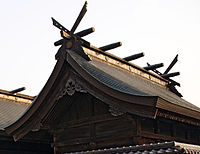Chigi (architecture)

Chigi architecture is a special style of architecture that originated in Japan. It is characterized by the use of raised wooden structures at the top of the roof, which are called chigi.
Now, imagine a house with a sloping roof that is made out of wood pieces. At the top of the roof, you might see some wooden pieces that stick up, almost like antennas. These are the chigi.
In the olden days, chigi were mostly found on the roofs of shrines and temples. This is because they were believed to protect the building and its inhabitants from evil spirits.
Chigi are often paired with another wooden structure called katsuogi which is a horizontal beam that runs across the roof. It is said that the katsuogi helps to keep the chigi in place, so that they don't fly away during a storm.
Chigi are also an important part of Japanese aesthetics. They add a decorative element to the traditional wooden architecture, and are often seen as a symbol of Japanese culture.
So to summarize, chigi architecture is a special style of Japanese architecture that features wooden structures called chigi, which are raised at the top of the roof to protect the building and add a decorative element.
Now, imagine a house with a sloping roof that is made out of wood pieces. At the top of the roof, you might see some wooden pieces that stick up, almost like antennas. These are the chigi.
In the olden days, chigi were mostly found on the roofs of shrines and temples. This is because they were believed to protect the building and its inhabitants from evil spirits.
Chigi are often paired with another wooden structure called katsuogi which is a horizontal beam that runs across the roof. It is said that the katsuogi helps to keep the chigi in place, so that they don't fly away during a storm.
Chigi are also an important part of Japanese aesthetics. They add a decorative element to the traditional wooden architecture, and are often seen as a symbol of Japanese culture.
So to summarize, chigi architecture is a special style of Japanese architecture that features wooden structures called chigi, which are raised at the top of the roof to protect the building and add a decorative element.
